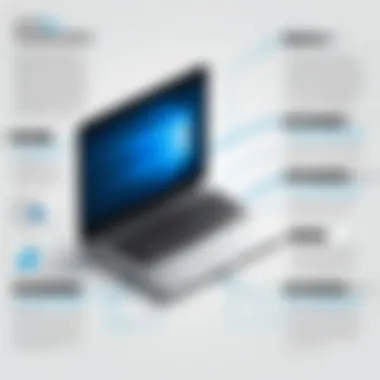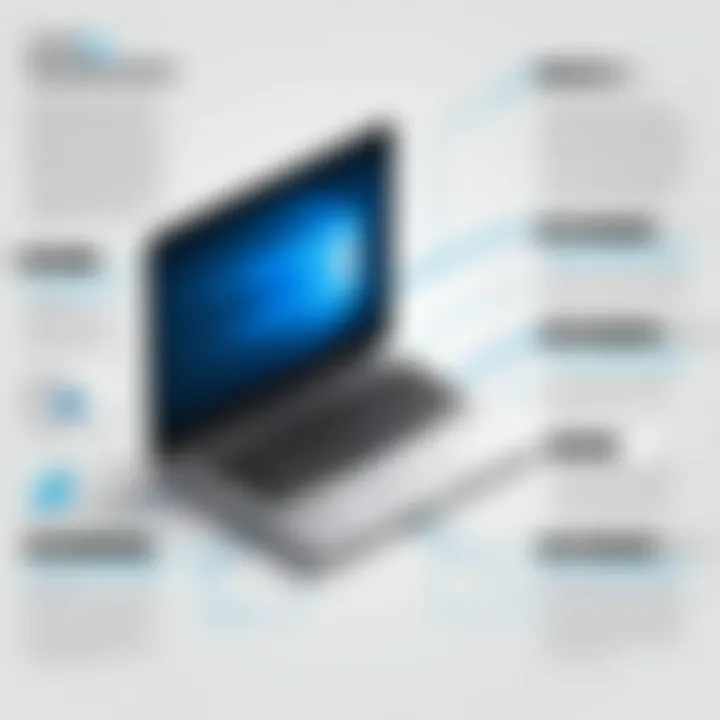Exploring the Impact of Certified EHR Software


Intro
In today's rapidly evolving healthcare landscape, certified electronic health record (EHR) software plays a pivotal role. This software is more than just a digital filing cabinet; it's a sophisticated system that can transform patient care and operational efficiency in clinics and hospitals. By reliably capturing and storing patient information, integrating various care processes, and promoting data sharing among healthcare teams, certified EHR systems are essentially becoming the backbone of modern healthcare practices.
The significance of certification cannot be understated. It ensures that the software adheres to certain standards and criteria set by regulatory bodies, providing healthcare providers with a dependable tool in their daily operations. In this article, we will explore the inner workings of certified EHR software: its features, the challenges of implementation, and its advantages over competitors in the market.
Software Overview
Brief Description of Software
Certified EHR software is designed to facilitate the systematic collection of patient data in a digital format. This system allows healthcare providers to track clinical information while sharing pertinent details across different medical facilities. The result? A more cohesive approach to patient care that can lead to better outcomes. Imagine a scenario where a patient moves from one doctor to another; with EHR, the new healthcare provider has immediate access to the patient's complete history, eliminating the game of telephone that can occur with paper records.
Key Features and Functionalities
The remarkable functionality of certified EHR software goes beyond mere record-keeping. Here are some of the key features:
- Interoperability: The ability to integrate and communicate with other systems enables seamless data sharing across different healthcare providers.
- User-friendly interfaces: Intuitive designs make it easier for healthcare staff to enter and access the information they need.
- Clinical decision support: Automated alerts and reminders aid physicians in making informed choices during clinical evaluations.
- Data analytics: Tools that provide insights into patient populations and identify trends can significantly enhance care outcomes and resource allocation.
- Regulatory compliance: EHR systems designed with compliance in mind ensure that providers meet the necessary standards, avoiding potential legal pitfalls.
Overall, well-crafted certified EHR systems can create efficiencies and strengthen patient engagement by making information readily available and accessible. As healthcare continues to evolve, staying current on these technologies is crucial for decision-makers who aim to lead their organizations effectively.
Detailed Comparison
Comparison with Competitors
While there are many players in the EHR market, a careful examination reveals significant differences in functionality and user experience. For instance, companies like Epic and Cerner have built robust ecosystems that provide scalability for larger healthcare organizations, focusing on comprehensive solutions. And then there are more niche offerings from companies like Athenahealth or NextGen, which cater primarily to smaller practices, providing flexibility and lower costs.
Key takeaways on some main competitors include:
- Epic: Well-known for its robust user experience but can be cost-prohibitive.
- Cerner: Great for larger systems but sometimes critiqued for complexity.
- Athenahealth: Offers an appealing pricing model but may lack features necessary for larger enterprises.
Pricing Structure
The pricing for certified EHR software can vary widely, depending on the features and services included. Commonly, providers may encounter pricing structures like:
- Subscription-based models: Monthly or annual fees allow access to the software, often including ongoing updates and support.
- One-time licensing fees: An upfront cost to purchase the software, although this might not cover future updates.
- Pay-per-use: Charges based on the number of transactions or records processed.
Most importantly, organizations must carefully consider not only the initial costs but also the long-term investment and potential savings tied to improved operational efficiency and care outcomes.
Prolusion to Certified EHR Software
The landscape of healthcare is constantly evolving, and the role of Electronic Health Records (EHR) has become a central piece of this transformation. Understanding certified EHR software is not just a matter of keeping up with technology; it is about ensuring quality healthcare delivery, patient safety, and operational efficiency in a world where information is key.
Defining Electronic Health Records
Electronic Health Records are digital versions of patients' paper charts. They are real-time, patient-centered records that make information available instantly and securely to authorized users. EHRs include a broad range of data, such as medical history, medications, allergies, lab results, and radiology images. The key here is that they are more than just a digital file; they enhance the quality of care by providing a comprehensive view of the patient’s health.
In essence, EHRs aim to streamline the documentation process. Unlike traditional paper charting, they allow for easier updates, mobility, and access to information across different healthcare settings. For instance, a doctor in an emergency room can access a patient’s history without having to call another facility, reducing wait times and increasing the accuracy of care.
Importance of Certification
The certification of EHR software is a significant indicator of reliability. It ensures that the software meets specific standards and requirements established by regulatory authorities. Certification is critical for multiple reasons:
- Interoperability: Certified EHR systems are designed to work with other health IT systems, making it easier for different providers to share information efficiently. This ability to communicate impacts patient care directly.
- Quality Assurance: Certification means the software has undergone rigorous testing and meets established healthcare regulations. This reassures healthcare providers that they are using a dependable product.
- Financial Incentives: Many healthcare organizations receive financial benefits for using certified EHR systems. Programs like Medicare's Meaningful Use offer incentives for providers who use these systems effectively.
"Certified EHR software not only boosts operational efficiency but also plays a pivotal role in enhancing patient care by ensuring that all relevant health information is readily available and accurate."
By focusing on these aspects, certified EHR software becomes not just a tool for digitizing records but a cornerstone of modern healthcare. In the following sections, we will explore the criteria for certification in depth, so providers can fully understand what makes an EHR system truly worthwhile.
Criteria for EHR Certification
The criteria for Electronic Health Record (EHR) certification play a pivotal role in shaping how healthcare organizations interact with patient data. These standards ensure that EHR systems meet specific requirements that bolster both functionality and security, thus enhancing patient care and operational efficiency. With the increasing complexity of healthcare IT, understanding these criteria is crucial for decision-makers, IT professionals, and healthcare entrepreneurs.
Regulatory Standards
Implementing regulatory standards establishes a foundational framework that certified EHR systems must adhere to. These standards ensure that EHR software is not just functional but also compliant with laws and regulations that govern healthcare practices. For instance, the Office of the National Coordinator for Health Information Technology (ONC) has laid out criteria that encompass various operational aspects of EHR systems, including data privacy and security, user engagement, and clinical decision support.
"Regulatory standards act as guardrails, giving healthcare providers clear guidelines on how to properly manage and protect patient data while optimizing workflows."
The Health Insurance Portability and Accountability Act (HIPAA) is one of the primary regulations influencing EHR certification. It mandates stringent data safeguards to protect patient privacy, compelling EHR developers to integrate robust security features into their systems. Moreover, any EHR software aiming for certification must go through rigorous scrutiny to ensure it complies with these regulations, thus serving as a guarantee to users that they are working with a secure platform.
Eligibility Requirements
Eligibility requirements for EHR certification focus not just on the software, but also extend to the organizations that choose to implement these systems. Vendors need to demonstrate that their EHR systems possess capabilities suited for a variety of healthcare settings. This includes support for diverse medical practices, specialty services, and various sizes of practices, from smaller clinics to large healthcare networks.
The Functional Criteria outlined by the ONC require that certified EHR systems meet certain performance benchmarks. This may involve aspects such as:
- Data Sharing Capabilities: EHR software must allow seamless data exchange with other systems.
- Usability: The system should be easy to use for healthcare professionals, ensuring a smooth workflow.
- Interoperability: Ability to integrate with existing technologies and facilitate data exchange across platforms.
- Security Measures: Requirements for implementing basic security protocols to ensure patient confidentiality.
Having these eligibility requirements in place is essential. They not only help standardize EHR functionalities but also protect healthcare providers, ensuring that they are investing in software that truly enhances patient care and operational practices.


Testing and Validation Process
The testing and validation process serves as a critical checkpoint in the journey toward EHR certification. This phase is often a comprehensive evaluation of the software’s functionalities, where various performance metrics are assessed. Ensuring accuracy in clinical data management is a key focus during this process.
Before certification, the software undergoes various testing methodologies, including:
- Functional Testing: Verifies whether the EHR performs according to the specified requirements.
- Interoperability Testing: Checks if the EHR can effectively exchange health information with other systems.
- Performance Testing: Assesses the system’s responsiveness and stability under load.
Successful testing not only triggers the certification but also validates the EHR’s capabilities so that healthcare providers can make informed choices. When healthcare organizations invest in certified EHR software, they can indeed be confident that the systems have passed thorough validation, ensuring the reliability of health records and ultimately enhancing the quality of care provided to patients.
Types of Certified EHR Software
The landscape of certified Electronic Health Record (EHR) software can often feel like traversing a labyrinth. Recognizing the different types of EHR systems is crucial, as each type serves specific needs that can enhance clinical workflows and patient outcomes. As healthcare providers search for solutions tailored to their unique requirements, understanding these classifications becomes vital.
General-purpose EHR Systems
General-purpose EHR systems act like the Swiss Army knife of healthcare technology—versatile and adaptable. These solutions are designed to support a wide range of medical practices, making them suitable for general medical facilities such as family practices and outpatient clinics.
The key characteristic of general-purpose systems is their broad functionality. They usually incorporate features like patient scheduling, billing, and documentation, providing a comprehensive approach that fits numerous specialties. Such systems can often integrate seamlessly with third-party applications, allowing providers to tailor functionalities to specific workflows rather than settle for one-size-fits-all software.
However, their adaptability does not come without its challenges. Providers may find that while they get essential functionalities, specialized needs may be overlooked compared to niche solutions. An important consideration when evaluating these systems is to assess how well they address specific workflows unique to certain specialties.
Specialized EHR Solutions
Diving deeper into the spectrum, specialized EHR solutions cater to particular medical fields, providing tailored functionalities designed to meet unique practice needs. These systems are crafted for specific niches such as pediatrics, internal medicine, and obstetrics and gynecology, ensuring providers have the tools necessary for their specialty.
Pediatrics
Pediatric EHR systems focus on the nuances of child health. They are tailored to incorporate features like growth charts, immunization records, and developmental milestone tracking that are not typically emphasized in general-purpose systems. The ability to monitor patient data specific to children's health is a key characteristic that sets these solutions apart.
The unique feature of pediatric EHR is its emphasis on family involvement in healthcare. These systems often include functionalities enabling better communication with parents or guardians about treatments or care plans, which can enhance patient-family interactions. However, one disadvantage is that pediatric-specific solutions might lack the broader adaptability—hence a consideration for practices that may treat both adults and children.
Internal Medicine
Internal medicine EHR solutions are designed for practitioners focusing on adult medicine, emphasizing comprehensive adult health management. A notable characteristic of these systems is their capability to manage multiple chronic conditions efficiently, which is vital in this era where patients often present with complex health issues.
What sets internal medicine EHR apart is its advanced clinical decision support tools that assist physicians in diagnosing and managing longstanding illnesses. By integrating lab results and patient history, these systems provide a supportive framework for intricate decision-making. A potential downside here is that smaller practices may find the extensive features to be overwhelming or unnecessarily complex for their patient population.
Obstetrics and Gynecology
EHR solutions for obstetrics and gynecology are specialized to meet the needs of women’s health. This software includes unique features like antepartum and postpartum tracking, as well as gynecological history assessments.
The focus on pregnancy and female reproductive health is a distinguishing factor that makes these systems pivotal in ensuring comprehensive care. They also often incorporate tools for ultrasounds and prenatal visits, ensuring healthcare providers have all necessary data readily available. However, a concern for practices focusing primarily on women’s health is that such specific systems may lack wider functionalities that could be beneficial for managing concurrent health issues, thereby limiting cross-specialty interoperability.
Cloud-based EHR Software
Shifting gears, cloud-based EHR software presents another frontier in EHR solutions. These systems operate on a subscription basis through internet access, allowing healthcare providers to tap into robust functionality without the hefty price tag associated with traditional installations.
Benefits include flexibility, scalability, and the ability to access records from various locations, which is especially pertinent in today’s increasingly mobile healthcare environment. A consideration is the reliance on internet connectivity, without which access to critical patient data could be hindered. Privacy concerns also loom large, making compliance with regulations like HIPAA a paramount aspect for cloud-based solutions.
In summary, the right EHR system for a provider’s practice hinges on understanding the differences between general-purpose and specialized EHR solutions, with considerations for current and future needs.
Advantages of Certified EHR Software
Certified Electronic Health Record (EHR) software isn’t just another tech gizmo cooking in the kitchens of healthcare providers. It’s become fundamentally necessary in weaving efficiency, compliance, and quality of care into the fabric of modern medicine. In this section, we will navigate through the multifaceted advantages of implementing certified EHR systems, which go well beyond just digitizing patient records.
Improved Patient Care
At the core of any healthcare system is patient care. Certified EHR software enhances this aspect by allowing healthcare providers to access patient histories at the click of a button. This immediacy offers clear advantages during consultations. For instance, imagine a doctor needing to make a critical decision about administering a medication to a patient with a complex medical history. With certified EHR software, all relevant data is readily available, reducing chances of medical errors.
Additionally, features like reminders for screenings and vaccinations help ensure patients receive preventative care. Furthermore, data integration with lab results and imaging enhances collaboration among specialists. This not only streamlines the process but also enables informed decisions for better health outcomes. Consider this:
"In healthcare, a split second can be the difference between life and death. Certified EHR helps save those precious seconds."
Operational Efficiency
When it comes to running a healthcare facility, efficiency is key. Certified EHR software aligns workflows in a way that allows healthcare professionals to focus on what they do best—taking care of patients. Manual data entry is a headache, and with EHR systems, it’s nearly a thing of the past.
According to a study published by the American Medical Association, practices that utilize certified EHR systems report a decrease in administrative time by up to 30%. This frees up staff who can then allocate that time toward patient interaction and support. Consider how operational tasks like billing and appointment scheduling become smoother flows rather than turbulent storms with the correct EHR system in place.
Moreover, automation is another strong suit of EHR software. By automating repetitive tasks like appointment reminders and outcomes data reporting, clinics can reduce the burden on staff and increase overall productivity.
Data Analytics and Reporting
In an increasingly data-driven world, the power of information cannot be understated. Certified EHR software offers extensive analytics and reporting capabilities that allow healthcare providers to track patient outcomes, identify trends, and comply with reporting requirements set by different governing bodies.
These systems facilitate the generation of comprehensive reports that can spot potential issues before they escalate, be it identifying an uptick in a particular diagnosis or monitoring adherence to treatment plans. The true value lies in data-driven decisions, where healthcare providers can use insights gathered from analytics to tweak operational strategies or improve patient care protocols.
For instance, a clinic can utilize data analytics to see which treatments yield the best outcomes for diabetes management and subsequently adjust their focus accordingly. This creates a circle of continuous improvement, leading to better patient care and increased operational productivity.


By investing in certified EHR software, healthcare practices not only enhance patient care but also streamline their operations and harness the power of data, ultimately leading to a sustainable model for delivering quality health services.
Integration with Other Healthcare Technologies
Integration with other healthcare technologies is an essential aspect of certified EHR software. This interoperability ensures that systems can communicate effectively and share information seamlessly, which is crucial for enhancing patient care and streamlining healthcare operations. Without this integration, healthcare providers could find themselves navigating a maze of disconnected systems, leading to inefficiencies and potential gaps in patient management.
Interoperability Standards
Interoperability standards are the backbone of effective integration. These standards provide a framework for how different EHR systems and healthcare technologies interact. The most notable among them is the Fast Healthcare Interoperability Resources (FHIR) standard. FHIR allows for the exchange of healthcare information in a more standardized and streamlined format, enabling developers to build applications that can connect various systems easily.
Being compliant with interoperability standards offers several advantages:
- Enhanced Communication: Systems adhering to the same standards can share data in real-time.
- Improvement in Clinical Outcomes: Better access to comprehensive patient information allows providers to make informed decisions quickly.
- Reduced Costs: Integrating various systems can eliminate redundant processes, saving time and resources.
Overall, interoperability standards are not merely guidelines but pivotal components that reinforce the strength of an EHR system by improving efficiency and efficacy across the healthcare landscape.
Integration with Practice Management Software
Integrating EHR software with practice management systems is another critical aspect of ensuring operational efficiency in healthcare settings. Practice management software typically includes features for scheduling appointments, billing, and managing patient information. When EHR and practice management systems work together, healthcare providers are able to streamline their workflow significantly.
Here are some of the key benefits of this integration:
- Facilitated Patient Flow: Appointment scheduling and patient visit documentation can be automated, reducing wait times.
- Unified Billing Processes: Having direct access to patient records when billing leads to fewer errors and quicker reimbursements.
- Improved Reporting: Integration enables comprehensive analyses of patient metrics and billing histories, which can be beneficial for strategic decision-making.
This synergy ensures that healthcare teams have a holistic view of patient interactions, ultimately benefiting both staff and patients.
Compatibility with Health Information Exchanges
Health Information Exchanges (HIEs) play a significant role in the landscape of healthcare technology by allowing for the electronic exchange of health information across different organizations. EHR software that is compatible with HIEs empowers healthcare providers to access critical patient information, regardless of where care was received.
The benefits of HIE-compatible EHR systems include:
- Access to Comprehensive Data: Providers can retrieve patients' medical histories from multiple sources, which aids in better diagnosis and treatment plans.
- Enhanced Care Coordination: When multiple providers are involved in a patient's care, platforms that connect through HIEs ensure that everyone is on the same page.
- Increased Patient Safety: Immediate access to medical records helps in avoiding medication errors and duplicate tests.
Challenges in EHR Implementation
Implementing Certified EHR software in a healthcare setting is no walk in the park. While these systems promise a treasure chest of benefits—like improved patient care and streamlined operations—they also come with a suitcase full of challenges that need addressing. Understanding these hurdles is vital for decision-makers and IT professionals, as this knowledge not only prepares them for potential pitfalls but also equips them to navigate through them.
User Resistance
User resistance often looms large during the EHR implementation phase. Healthcare professionals, accustomed to their traditional methods and systems, may feel overwhelmed by the change. The fact is, altering workflows and altering how individuals record and access information isn't a walk in the park.
Many staff members may express concerns about data security or just feel blindsided by how much they need to learn. To mitigate this, it’s key to involve users early in the process. Gather their feedback when assessing potential EHR systems, and invest in comprehensive training programs that not just teach how to use the software but also explain why the change is necessary.
"The most significant resistance to change often comes from those who are asked to change. It's essential to ensure everyone understands how the new system improves their day-to-day tasks and ultimately benefits patient care."
Technical Issues During Implementation
Then there's the realm of technical issues. Even with the best of intentions and preparations, glitches can hit like a bolt from the blue during EHR implementation. This may include network outages, software bugs, or even hardware compatibility problems. When technology fails to cooperate, it can lead to frustrating delays and can end up costing both time and money.
To tackle these concerns, it's crucial for organizations to work closely with their vendors. Establishing a robust IT support system before rolling out the EHR software is a must. Ongoing testing during the implementation phase can also uncover potential hiccups early, allowing for adjustments before the system goes live.
Ongoing Maintenance and Support
Finally, the challenges don’t end once the EHR is up and running. Ongoing maintenance and support play a pivotal role in ensuring that the system remains effective, especially as regulations evolve and as new technologies emerge. Without continuous updates and user support, even the most advanced EHR systems can become outdated really quickly.
It’s not just about fixing bugs anymore; organizations need ongoing training initiatives to keep health professionals proficient in using EHR features. Additionally, creating feedback channels where users can report issues or suggest improvements foster a culture of continuous enhancement.
In essence, EHR implementation might feel like trying to juggle flaming torches; there are always many things to keep in the air. But recognizing these challenges is the first step. With knowledge, planning, and a bit of negotiation, healthcare providers can effectively manage these obstacles—transforming them into stepping stones toward improved patient care and operational excellence.
Legal and Regulatory Compliance
In the landscape of certified Electronic Health Record (EHR) software, the significance of legal and regulatory compliance cannot be overstated. It serves as the backbone that ensures the integrity, security, and confidentiality of patient information while facilitating healthcare providers to operate within the framework of the law. Compliance touches on various aspects, including patient privacy, data security, and the efficacy of healthcare delivery.
The landscape of healthcare regulations is vast and complex, which is why it’s critical for decision-makers and IT professionals to remain aptly informed on the specifics that would influence their operations. Ignoring these requirements could lead to hefty fines, legal entanglements, and irreparable damage to a provider's reputation. Understanding these facets empowers organizations to mitigate risks while reaping the numerous benefits of EHR adoption.
HIPAA Regulations
One of the cornerstone pieces of legislation governing EHR software is the Health Insurance Portability and Accountability Act (HIPAA). This federal law was enacted to protect sensitive patient information from being disclosed without consent. In practice, this means that all EHR systems must implement stringent data protection measures to safeguard health records.
Key Elements of HIPAA Compliance:
- Privacy Rule: This section ensures that individuals have rights over their health information, including who can access it.
- Security Rule: Mandates safeguarding electronic protected health information (ePHI) through physical, administrative, and technical safeguards.
- Breach Notification Rule: Requires organizations to notify patients when their data is compromised.
By adhering to HIPAA guidelines, healthcare organizations not only comply with the law but also foster trust with consumers. For instance, if a patient feels secure that their sensitive information is well-guarded, they are more likely to share crucial health details, enriching the quality of care they receive.
Meaningful Use Requirements
Another set of regulations that EHR software must address are the Meaningful Use requirements. These stipulations were designed to encourage the adoption and use of EHR technology by healthcare providers, offering incentives for those who demonstrate meaningful engagement with the system.


Benefits of Meeting Meaningful Use Requirements:
- Improved Quality of Care: EHRs that meet these criteria enhance patient care delivery through better data sharing and informed decision-making.
- Enhanced Coordination of Care: Ensures a smoother transition of patient data among providers, reducing repetitive tests and improving outcomes.
- Financial Incentives: Practices that comply can qualify for both financial incentives and later avoid penalties.
The criteria for Meaningful Use often evolve, encouraging continual investment in upgrading EHR systems. This ongoing evolution not only benefits the healthcare organizations but reflects a broader goal of achieving a data-driven approach to patient health management.
"Adherence to these standards is not merely about compliance but about fostering a culture of accountability, transparency, and excellence in patient care."
Selecting the Right EHR Software
When it comes to navigating the seemingly vast landscape of certified Electronic Health Record (EHR) software, one key aspect stands out: selecting the right EHR software for your healthcare organization. The choices are numerous and the stakes are high, as the right EHR system can dramatically improve both patient outcomes and operational efficiency. With healthcare providers striving to deliver quality care in a fast-paced environment often plagued by tight budgets and limited resources, understanding what to prioritize in an EHR selection process is crucial.
Assessing Organizational Needs
Before diving into vendor offerings, it’s essential to have a solid understanding of your organization’s specific requirements. Each practice is unique, with different patient populations, workflows, and providers. To kick off this process, healthcare leaders should consider asking:
- What are the specific functionalities we need? (e.g., appointments, billing, telemedicine)
- How does our current workflow operate, and how can an EHR enhance it?
- What are our goals for the EHR implementation? Is it focused on improving patient engagement, data management, or regulatory compliance?
It can be helpful to engage stakeholders across various departments—from receptionists to clinicians—so that their perspectives can guide the decision-making process. Ultimately, taking the time to assess the organization’s needs improves the chance of finding a user-friendly solution that integrates well into existing operations.
Evaluating Vendor Options
With a clearer idea of your needs, the next logical step is vetting potential vendors. It’s easy to get lost in the shiny features and bells-and-whistles that EHR systems proudly display, but keeping a laser-focus on your documented needs is vital. Here are some points to consider while evaluating different EHR options:
- Reputation and reviews: Check for testimonials from current users or third-party sites for insights into vendor performance.
- Customization: Verify whether the system allows for tailored features to fit your unique workflows.
- Support and training: Does the vendor provide adequate support during and after implementation? Are they willing to train your team thoroughly?
- Cost: Just like shopping for a car, compare not just the upfront costs, but also ongoing subscription fees, training expenses, and potential costs for upgrades.
- Interoperability: Consider how well the EHR can communicate with other systems in use, such as practice management software or billing systems.
Implementation Strategies
Once the right EHR system is chosen, the path to successful implementation isn’t without potential hiccups. It’s essential to devise a well-thought-out implementation strategy. Here are some practical steps:
- Establish a timeline: Map out a realistic timeline for implementation, allowing sufficient time to address each phase, from data migration to staff training.
- Create a cross-functional team: Bringing together team members from different roles can provide a more comprehensive view of what needs to be tackled during implementation.
- Training and support: Ensure that all users receive adequate training before the system goes live, and plan for ongoing support; small misunderstandings can lead to larger issues down the line.
- Feedback mechanisms: Establish protocols for soliciting feedback from users during the rollout phase, so that any issues that arise can be addressed quickly and efficiently.
Implementing the right EHR software is about more than just functionality; it’s about enhancing the overall quality of care provided to patients. Selecting the right system means considering the needs of the organization, conducting thorough evaluations of vendor options, and developing robust strategies for implementation. As healthcare continues to evolve, taking these steps can ensure that your practice remains on the cutting edge, delivering both efficient and effective patient care.
"Selecting the right EHR software is a journey—one that, when done thoughtfully, can lead organizations toward their goals in technology-driven healthcare."
By following these guidelines and maintaining a focus on organizational needs, healthcare providers can navigate their EHR journey with greater confidence.
Future Trends in EHR Software
The healthcare landscape is ever-evolving, and so are the tools that facilitate it. Understanding the future trends in Electronic Health Record (EHR) software is not just a matter of keeping pace; it’s about staying ahead. For decision-makers, IT professionals, and entrepreneurs in the healthcare sector, recognizing these trends can inform strategic planning and implementation decisions. Two key areas where advancements are poised to make significant impacts are Artificial Intelligence and Telehealth Integration.
Artificial Intelligence and Machine Learning
As we look to the future, Artificial Intelligence (AI) and Machine Learning (ML) are setting the stage to redefine how EHRs function. These technologies can analyze vast amounts of patient data efficiently, uncovering patterns that aid in diagnosis and treatment. AI algorithms can assist clinicians in making more informed decisions by providing evidence-based recommendations, ultimately improving patient outcomes.
- Predictive Analytics: AI can tackle the prediction of patient deterioration before symptoms manifest. For instance, an algorithm might analyze data from previous patients to identify those at risk of sepsis based on their vital signs.
- Natural Language Processing (NLP): This component allows EHR systems to process and interpret clinical notes written in plain language. NLP can help extract relevant information quickly, streamlining documentation and enhancing the patient-provider exchange.
- Enhanced User Experience: With machine learning, EHR systems can tailor user interfaces based on individual clinician behaviors. This means less time fiddling with unnecessary features, enabling healthcare providers to focus on what truly matters—their patients.
Implementing AI and ML isn't without its challenges; issues like data privacy and algorithmic bias need to be addressed. But as these technologies evolve, they promise to significantly enrich the functionality and efficiency of EHR software.
Telehealth Integration
The pandemic woke many healthcare providers and patients up to the reality of telehealth. As it slowly becomes a standard part of healthcare delivery, EHRs have to adapt accordingly. Effective telehealth integration within EHR systems is vital for maintaining continuity of care, especially in a hybrid care model where in-person and virtual visits coexist.
- Seamless Scheduling: EHRs can provide functionalities that enable providers to easily schedule virtual appointments alongside face-to-face ones, helping keep workflows smooth.
- Unified Patient Records: The necessity for synchronization between telehealth visits and in-person consultations allows providers to have a comprehensive view of patient health. This is crucial for continuity and effective follow-ups.
- Documentation and Compliance: Telehealth often requires unique documentation standards. Having these integrated into existing EHR systems ensures compliance with regulations and maintains the quality of care.
Moreover, as patients increasingly prefer convenience, telehealth integration becomes pivotal in patient engagement. This means EHR systems must prioritize user-friendly interfaces that are accessible on multiple platforms.
"The future of EHR software isn't merely about storage; it’s about fostering a richer, more connected healthcare experience."
In summary, the future of EHR software is being shaped by technologies like AI and the increasing demand for telehealth services. By harnessing these trends, healthcare providers can not only enhance operational efficiencies but also improve patient care quality, preparing themselves for a healthcare environment that is as agile as it is innovative.
Epilogue
As we wrap up our exploration of certified EHR software, it's critical to recognize the profound impact that these systems hold in the healthcare landscape. The ability to not only streamline operations but also enhance patient care cannot be underestimated. While navigating through the complexity of certification requirements, it's clear that the stakes are high for healthcare providers considering their options.
Summary of Key Points
In reflecting upon this subject, several key points surface:
- Certification's Role: Having certified EHR software ensures adherence to regulatory standards, which is essential for data security and operational efficiency.
- Types of EHR Software: From general-purpose systems to specialized solutions like those tailored for pediatrics or obstetrics, choosing the right type is vital for meeting specific organizational needs.
- Integration Benefits: The capacity for EHR systems to integrate with other healthcare technologies facilitates seamless data sharing, which ultimately leads to improved patient outcomes.
- Challenges Ahead: User resistance and technical issues during implementation can hinder progress. Awareness and thorough planning are necessary to mitigate these hurdles.
- Future Trends: With advances in artificial intelligence and telehealth, looking ahead can guide decision-makers toward solutions that not only satisfy current needs but anticipate future ones.
When healthcare organizations recognize these elements, they stand to reap significant benefits from certified EHR software.
Final Thoughts on EHR Software
In closing, the journey of implementing certified EHR software is an ongoing venture that requires careful analysis and commitment. One has to delve deep into organizational requirements, evaluate the interoperability of chosen systems, and be prepared for a metamorphosis in healthcare delivery. Each decision in this realm can affect patient care directly, making thorough contemplation not just a necessity, but a priority.
As the landscape of healthcare continues to evolve, embracing these technologies—even amidst the challenges—will be key to fostering a more agile, responsive, and effective healthcare system. The integration of certified EHR software is not just a matter of compliance; it is an investment in a future where patient care is enhanced and operational efficiency achieves new heights.
Furthermore, understanding these dynamics allows decision-makers, IT professionals, and entrepreneurs to navigate this complex environment with greater efficacy.
“In the world of healthcare, the choice of EHR software is akin to selecting the foundation of a house; it holds everything together.”
To this end, as the healthcare industry embraces the ongoing digital transformation, one thing remains clear: staying informed, adaptable, and focused on quality will pave the way for success in this ever-changing field.







